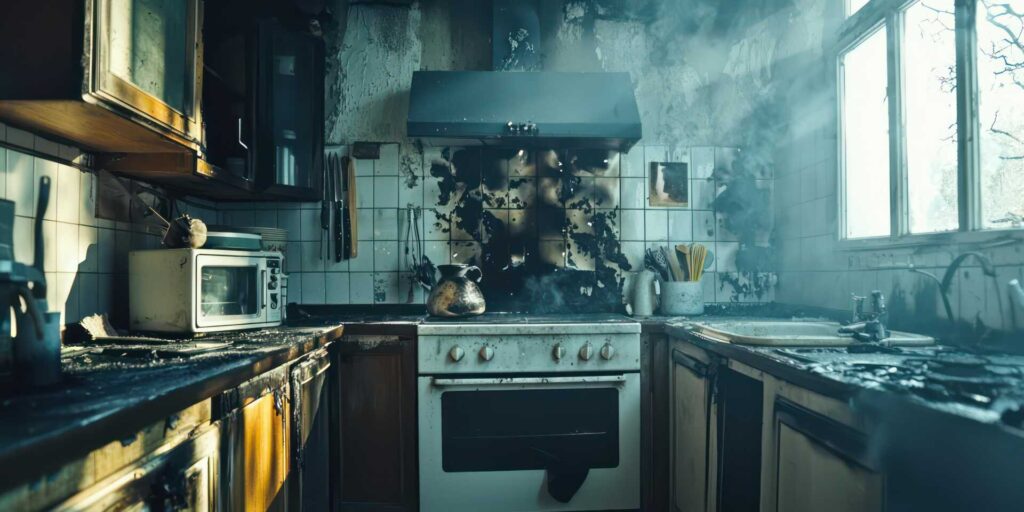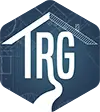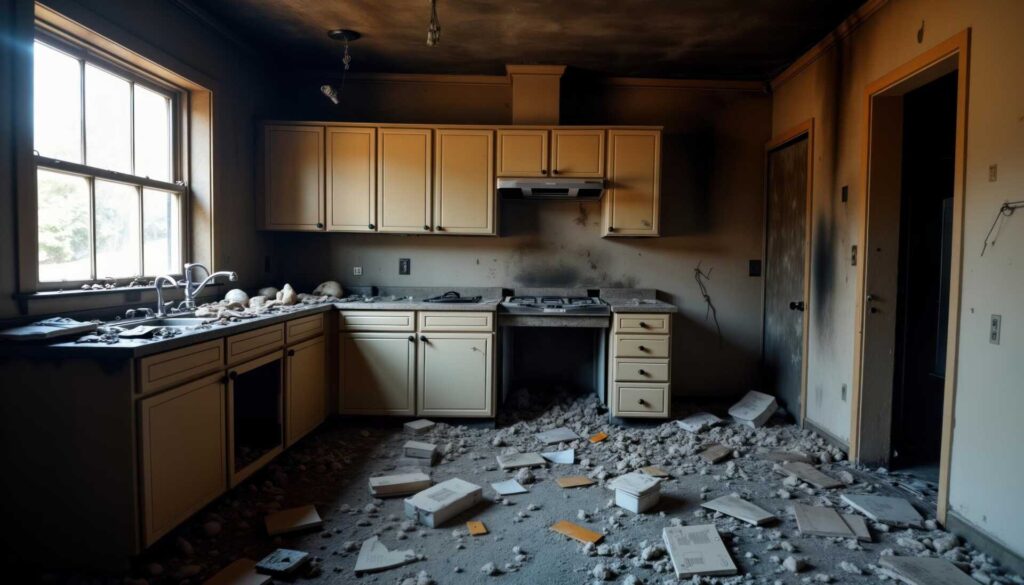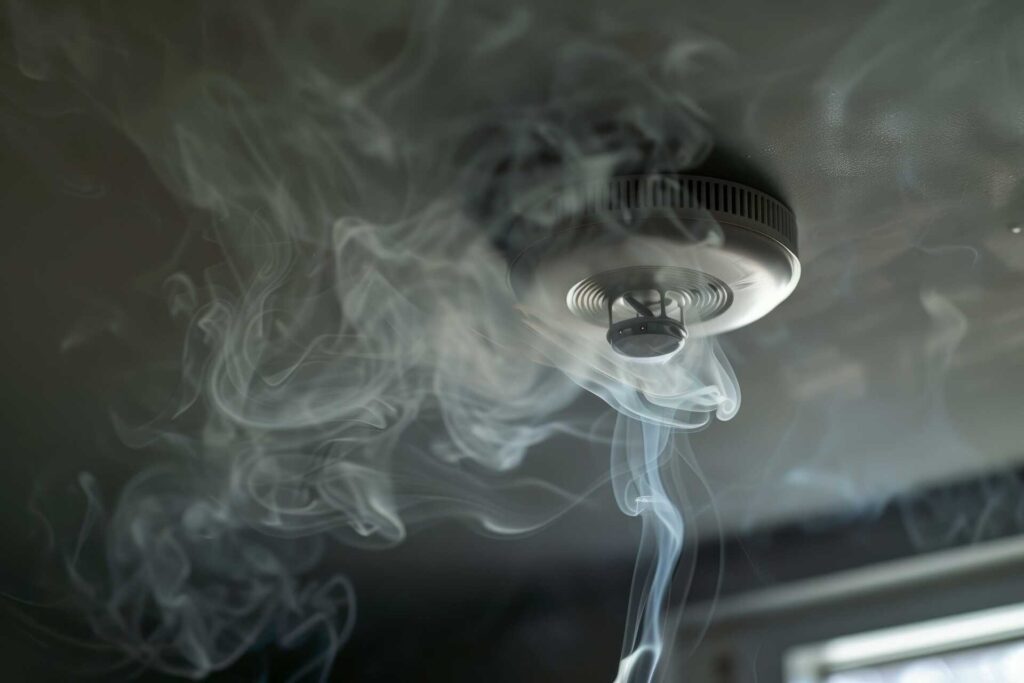
Contents
There are budget-friendly solutions you can implement to tackle both water and fire damage effectively. From simple DIY methods to cost-saving materials, you can manage the recovery process without breaking the bank. Let’s explore practical strategies that can help you take control of the situation while minimizing expenses.
Key Takeaways
- Use towels or mops to soak up excess water before employing a wet/dry vacuum for effective water removal.
- Clean soot and smoke odors with a mixture of water and vinegar, followed by specialized cleaning solutions.
- Document all damage thoroughly for insurance claims, ensuring all repairs are covered and costs are minimized.
- Seek out second-hand materials for replacing damaged items, which can significantly cut down on repair expenses.
- Engage local community organizations for support and resources, enhancing recovery efforts without high costs.
Understanding Water and Fire Damage
Water and fire damage can wreak havoc on your home, leading to costly repairs and emotional stress. Understanding water damage is essential for every homeowner. It can stem from burst pipes, heavy rains, or faulty appliances, turning your sanctuary into a nightmare.
The longer you wait to address these issues, the more extensive the damage becomes, creating a sense of urgency that can feel overwhelming.
On the other hand, fire damage effects can be equally devastating. Not only do flames consume your belongings, but smoke and soot can linger long after the fire is extinguished, affecting air quality and leaving behind a grim reminder of the event.
Recognizing these dangers helps you take proactive steps to protect your home and your family. You’re not alone in this struggle—many share your concerns, and together, we can find budget-friendly solutions to restore your peace of mind.
Assessing the Damage
Evaluating the damage after a water or fire incident is essential to determining your next steps. Start by gathering your assessment checklist, which will help you identify key damage indicators.
Look for signs like discoloration, warping, or mold growth in the case of water damage, and check for charred materials or lingering odors after a fire. Don’t rush; take your time to document everything, as this will be vital for insurance claims or future repairs.
Involve family members or friends in the process; having support makes it easier to tackle this overwhelming task. As you pinpoint areas of concern, remember that addressing these issues quickly can save you money down the line.
DIY Water Removal Techniques
When faced with water damage, taking swift action can make a significant difference in the recovery process. You can tackle the issue yourself with some effective DIY water removal techniques.
Start by focusing on water extraction and moisture control to prevent further damage and mold growth. Here are some simple steps to follow:
- Shut off the electricity to avoid hazards.
- Use towels or mops to soak up excess water.
- Employ a wet/dry vacuum for efficient water extraction.
- Set up fans and dehumidifiers to ensure moisture control.
Affordable Fire Damage Cleanup Methods
How can you effectively tackle the aftermath of a fire without breaking the bank? First, assess the damage and prioritize your needs.
For fire damage restoration, start with a thorough cleaning. Use a mixture of water and vinegar to clean surfaces and eliminate smoke odors—it’s a cost-effective cleanup that works wonders.
Next, tackle soot with a simple sponge and specialized cleaning solution. You don’t need to hire expensive professionals right away. Gather friends or family to help; they’ll appreciate being part of your recovery.
If you need to replace items, look for second-hand materials or community resources. Many local organizations offer support for fire victims, so don’t hesitate to reach out.
Budget-Friendly Materials for Repairs
After addressing the immediate aftermath of fire damage, it’s time to focus on repairs. You want solutions that are both budget-friendly and effective.
Here are some materials to evaluate:
Cost-effective insulation: Look for options that provide thermal efficiency without breaking the bank.
Recycled building materials reduce waste, save money, and add a unique touch to your home.
Plywood and OSB boards: Affordable alternatives to traditional lumber for structural repairs.
Masonry and concrete: Durable and often cost-effective for rebuilding walls or foundations.
Using these materials, you can create a safe and welcoming space again.
By choosing wisely, you contribute to a sustainable future while staying within your budget.
Insurance Options for Water and Fire Damage
Understanding your insurance options for water and fire damage is essential, especially since it can greatly impact your recovery process. You want to feel secure knowing that your insurance claim will cover the damages you face.
Start by reviewing your policy limits—these define how much your insurer will pay for various types of damage. Knowing these limits can help you prepare for any unexpected expenses.
Additionally, consider whether you have replacement cost coverage or actual cash value coverage. Replacement cost means you get the full amount to replace items, while actual cash value considers depreciation.
If you’re part of a community that values support, don’t hesitate to reach out to neighbors who’ve navigated similar situations for advice.
Finding Professional Help on a Budget
When you’re facing water or fire damage, finding affordable professional help is essential.
Look for local service discounts and explore your insurance coverage options to ease the financial burden.
You might also consider some DIY repair tips to tackle smaller issues on your own.
Local Service Discounts
How can you find affordable professional help for water and fire damage? Start by exploring local service discounts and community partnerships that can make a big difference in your repair costs.
Many local businesses offer discounts to residents, especially if they’re involved in community initiatives.
Here are some tips to find the right help:
- Ask for referrals from friends and family.
- Check local listings for companies that offer discounts.
- Inquire about partnerships with community organizations.
- Look for seasonal promotions or special offers.
Insurance Coverage Options
Many homeowners don’t realize that their insurance policies can greatly alleviate the costs associated with water and fire damage. Understanding different policy types and their coverage limits can help you make informed decisions.
Here’s a quick overview of common insurance options:
| Policy Type | Coverage Limits | Emotional Impact |
|---|---|---|
| Homeowners Insurance | Up to $300,000 | Peace of mind |
| Renters Insurance | Up to $100,000 | Security for your belongings |
| Flood Insurance | Up to $250,000 | Protection in unexpected times |
Exploring your coverage options protects your home and fosters a sense of community. By knowing what’s available, you can navigate water and fire damage with confidence, belonging to a network of informed homeowners.
DIY Repair Tips
Understanding your insurance coverage options is just the first step in handling water and fire damage.
Once you’re clear on that, it’s time to roll up your sleeves and tackle the repairs yourself. Here are some budget-friendly DIY repair tips that can save you money and give you a sense of accomplishment:
Gather essential repair tools like hammers, drills, and safety gear.
Learn basic restoration techniques online through tutorials or community workshops.
Use eco-friendly materials to minimize costs and environmental impact.
Connect with neighbors or friends who can lend a hand or share their experiences.
With a little effort and the right tools, you can effectively manage repairs while feeling empowered within your community.
Preventative Measures to Avoid Future Damage
While it’s easy to overlook, taking proactive steps can greatly reduce the risk of water and fire damage in your home. By investing in preventative maintenance and scheduling regular safety inspections, you create a safer environment for yourself and your loved ones. Here are some key measures you can take:
| Action | Frequency | Benefit |
|---|---|---|
| Inspect roof and gutters | Annually | Prevent leaks |
| Check smoke detectors | Monthly | Early fire detection |
| Test sump pumps | Biannually | Avoid flooding |
Don’t wait for a disaster to strike; these simple actions foster a sense of community and responsibility. When you prioritize safety, you’re not just protecting your home—you’re creating a haven for everyone who enters. Embrace these measures, and enjoy the peace of mind that comes with knowing you’re prepared.
Summary
Tackling water and fire damage doesn’t have to drain your wallet. By using simple DIY techniques and affordable materials, you can effectively manage the cleanup and repairs. Plus, engaging friends and family can make the process easier and more enjoyable. So, why not take control of the situation and turn a disaster into a manageable project? With the right approach, you’ll be back on your feet in no time, all while keeping costs low!





